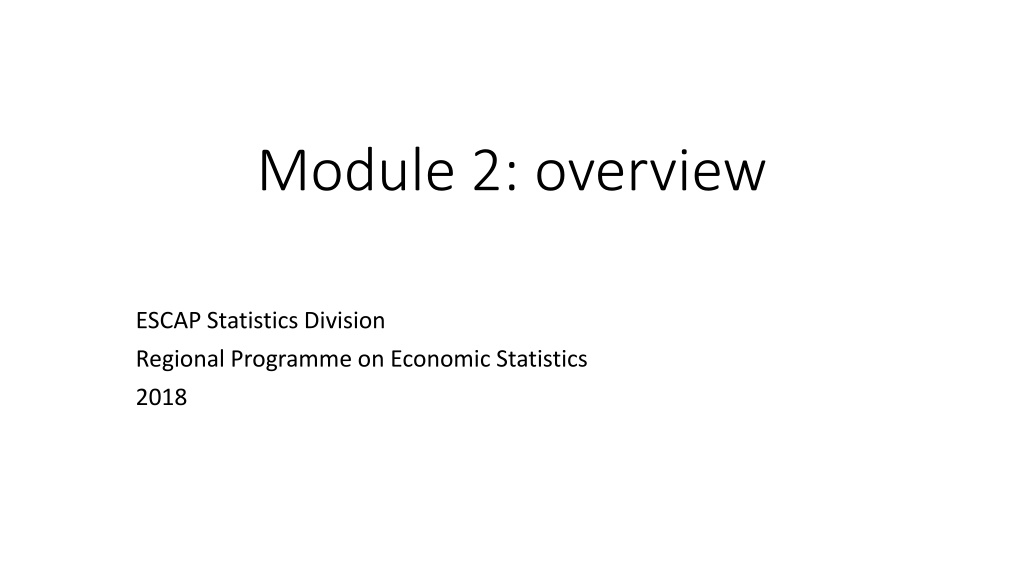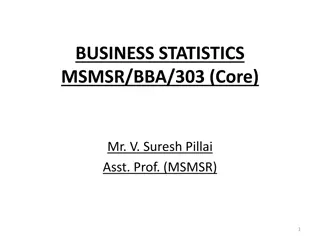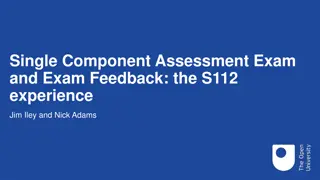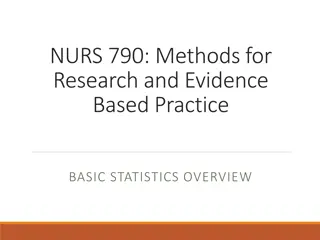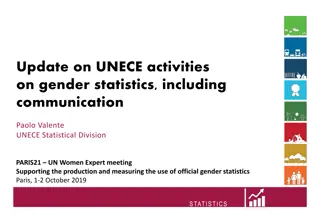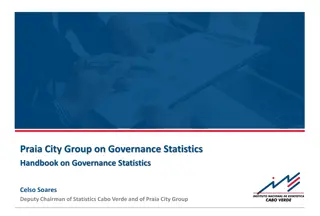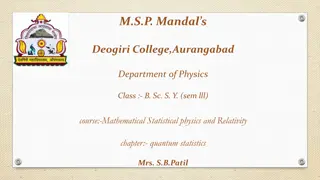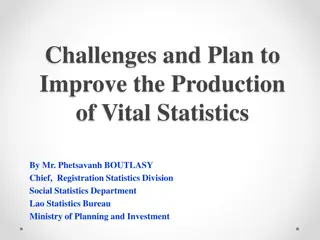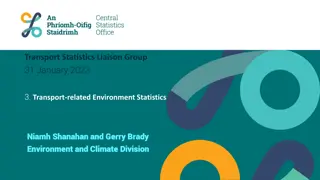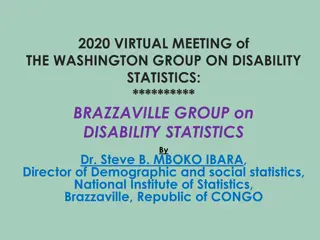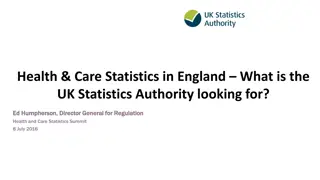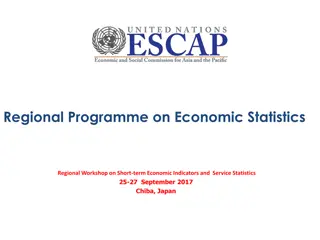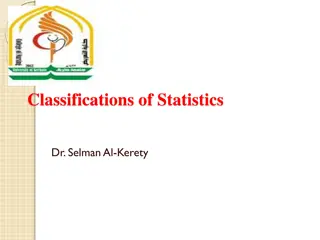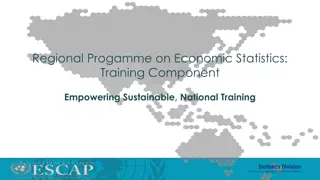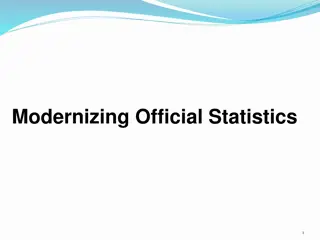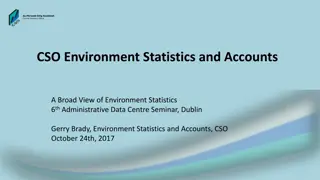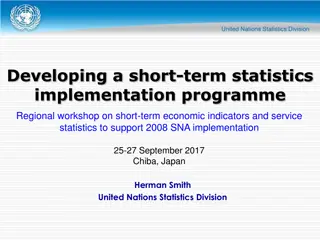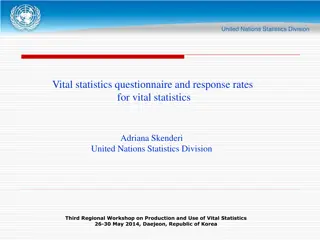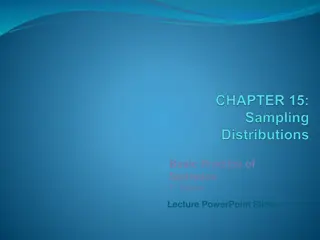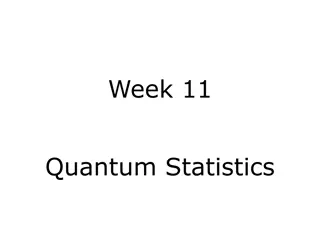Economic Statistics: Module 2 Overview
Exploring the fundamentals of measuring an economy through economic statistics, this module covers the Sustainable Development Goals, 2008 SNA framework, and uses of macro-economic data sets. It delves into the activities within an economy, the importance of measuring economic activities, and the System of National Accounts as a guiding framework.
Download Presentation

Please find below an Image/Link to download the presentation.
The content on the website is provided AS IS for your information and personal use only. It may not be sold, licensed, or shared on other websites without obtaining consent from the author.If you encounter any issues during the download, it is possible that the publisher has removed the file from their server.
You are allowed to download the files provided on this website for personal or commercial use, subject to the condition that they are used lawfully. All files are the property of their respective owners.
The content on the website is provided AS IS for your information and personal use only. It may not be sold, licensed, or shared on other websites without obtaining consent from the author.
E N D
Presentation Transcript
Module 2: overview ESCAP Statistics Division Regional Programme on Economic Statistics 2018
Introduction The economy Sustainable Development Goals (SDGs) Core Set of Economic Statistics 2008 SNA as a framework for measuring economic activity Links to other macro-economic data sets Uses and users of macro-economic statistics MF Module 2 version 2 2
An economy It s a place in which many many things going on people, households, businesses, governments, other organisations are doing things: Making things, growing things, buying and selling, borrowing and lending money They save and spend, they give things to others They obtain goods and services from other places, and sell and give things to other places They use and provide labour and skills, they use natural resources and man-made machines And we (statisticians and the government and others) would like to make some sense of all of this stuff going on MF Module 2 version 2 3
Measuring an economy Governments and other agencies would like to make some sense of all of this stuff going on So we (statisticians) want to observe measure organise/summarise and present information about the economy in a way that is meaningful to others we need some rules to describe and measure what is happening in an economy We use the System of National Accounts it provides a framework for explaining what is happening in an economy. MF Module 2 version 2 4
More formally - what is an economy? It includes the territory under the control of a government plus the resident entities individuals, businesses, government, other organisations Activities of production, distribution (trade) and consumption of goods and services AND accumulation Using available resources land and other natural resources, labour, capital, entrepreneurial skills and knowledge and other goods and services Formal and informal activities Legal and illegal activities Note: documentation metadata for publication and detailed documentation for users MF Module 2 version 2 5
Why do we want to measure what is happening? Macroeconomics studies the behaviour and performance of the economy Macroeconomic statistics describe what is taking place in a period of time (transactions and other flows) and Where the economy is at particular points in time (stocks) the economy s balance sheet a statement of its assets and liabilities (and thus net worth) at one or more particular point Measure these activities and positions in a timely way to meet the demand for robust statistics for informed decision making and policy making, along with monitoring and evaluation of outcomes MF Module 2 version 2 6
In macro-economic (and other) statistics Classify and aggregate detailed data using agreed classification and aggregation systems To provide comprehensive, consistent, but condensed information to people and institutions that want to use the information to: Monitor general economic performance Make rational economic decisions and monitor results Make informed policy, monitor progress Analyse how the economy works looking at how the pieces fit together and affect one another Evaluate the success of decisions and policies Including the monitoring of progress towards the SDGs MF Module 2 version 2 7
Sustainable Development Goals Member countries of the United Nations adopted the 2030 Development Agenda in September 2015 including the SDGs and their targets and thus agreed to work towards the goals. SDGs are universal, all UN member states are expected to use these to frame their agendas and government policies until 2030 17 goals, each has a set of targets and indicators to measure progress towards the goal Countries need to develop these indicators, so there is an increasing demand for statistics, including the Core Set, that are appropriate for measuring and monitoring these goals Information about the SDGs, and their targets and indicators may be found at the website of the UN Statistics Division https://unstats.un.org MF Module 2 version 2 8
The Core Set of Economic Statistics Developed by ESCAP in consultation with its member economies A minimum set of economic statistics that countries should be able to produce by 2020 Countries may prioritise components as they develop policy plans including those embodied in the SDGs The Regional Programme on Economic Statistics (RPES) is a platform for economies to share resources and experiences Skill domains of statisticians identify the set of skills that statisticians need to be able to produce the core set Further information on ESCAP s RPES may be found on the ESCAP website http://www.unescap.org MF Module 2 version 2 9
What statistics are in the Core Set? Prices and costs Demand and output Income and wealth Money and banking Government Labour market Natural resources and the environment Further information on the Core Statistics may be found on the ESCAP website http://www.unescap.org MF Module 2 version 2 10
Skill domains for statisticians Economic survey skills (that is, associated classifications, SNA concepts in surveys) Basic skills for price statisticians (that is, index number theory) Integrating household surveys into price statistics (that is, rebasing) ICT-enabled data analysis skills Quantitative measures (that is, volume measures employment, labour, production) The 2030 agenda for sustainable development The UN fundamental principles of official statistics Further information on the Skill Domains for Statisticians may be found on the ESCAP website http://www.unescap.org and on the Fundamental Principles at the UN Statistics Division website https://unstats.un.org. MF Module 2 version 2 11
GDP and much, much more Changes in GDP (production and/or expenditure based) in volume terms give information on growth rates a central statistic of the national accounts but other important information also arises from detailed GDP estimates: information by industry and institutional sector other information about changing prices values and volumes And much more beyond GDP Also central are two measures of price changes the CPI and the GDP deflator MF Module 2 version 2 12
The System of National Accounts (SNA 2008) An internationally agreed set of standards to measure economic activity Provides a framework that allows us to describe the economy s many transactors and transactions By organising (classifying) and condensing this information in a meaningful way Following conventions based on economic principles With an agreed set of concepts, definitions, classifications and accounting rules applying to all parts of the SNA system Giving rise to a comprehensive, consistent and integrated set of statistics that record economic activities within given period and the levels of an economy s assets and liabilities at particular points of time MF Module 2 version 2 13
SNA: General principles Comprehensive all designated activities are covered, and a great mass of detailed information lies beneath the aggregated information Consistent the SNA has consistent rules for concepts, definitions, classifications and accounting rules so that the same values are used for recording all sides of a single transaction Integrated all consequences of a single action are captured in the accounts and balance sheets, so altogether the system is balanced and closed MF Module 2 version 2 14
Basic information identified in the accounts Who? Does what? Concerning what? With whom? For what purposes? When? How to measure? How does this affect the stocks of non-financial assets and the financial assets and liabilities of the economy? MF Module 2 version 2 15
The Main Structure of the Accounts Goods and services Sequence of accounts Current accounts Accumulation accounts Balance sheets Other accounts Supply and use tables Accounts in volume terms MF Module 2 version 2 16
The goods and services account uses resources intermediate consumption output final consumption expenditure imports of goods and services gross capital formation gross fixed capital formations taxes on products changes in inventories less subsidies on products acquisitions less disposals of valuables exports of goods and services MF Module 2 version 2 17
Three measures of GDP There are three different approaches to measuring GDP the production approach the expenditure approach the income approach Many data sources are used for estimating these different approaches This means there will be discrepancies among the three measures MF Module 2 version 2 18
Accounts of the system Measure three kinds of economic activities: production, consumption and accumulation: Production providing the goods and services required by households, businesses, government and the rest of the world Consumption satisfying wants and needs immediately using goods and services to produce more goods and services in the future Accumulation retaining goods, services and assets for future use; and/or incurring liabilities Focus in this course is on production, consumption and capital formation MF Module 2 version 2 19
Current accounts of the SNA production account value added generation of income account operating surplus/mixed income allocation of primary income account balance of primary incomes secondary distribution of income account disposable income redistribution of income in kind account adjusted disposable income use of disposable income account saving use of adjusted disposable income account saving 20
Capital and financial accounts and balance sheets opening balance sheet capital account other changes in volume account revalu- ation account closing balance sheet net lending(+)/net borrowing financial account net worth net worth net lending(+)/net borrowing 21
the integrated accounts picture of the economy Production Generation, allocation, distribution, and use of income Other changes in volume of assets account Opening Stock Accumulation Closing Stock Net acquisitions of non- financial assets Net acquisitions of financial assets Net incurrence of liabilities Non-financial Assets Financial assets Liabilities Net worth Revaluation account MF Module 2 version 2 22
SNA: presentation Present time series in monetary values indexes growth rates Presentation as T-accounts matrix presentation (SUT) tables graphs give pictorial presentation of selected data MF Module 2 version 2 23
Boundaries what is included in an economy? National boundary defines the residents of an economy It consists of all of the economic units that are resident in the economic territory of a country An economic territory is the area under the effective economic control of a single government An economic entity is resident in one and only one economic territory determined by its centre of predominant economic activity MF Module 2 version 2 24
Economic Units comprise are grouped to Institutional sectors Institutional Units which can be partitioned into Establishments, local units, and kind-of- activity units Industries/ Economic activities MF Module 2 version 2 25
What is an institutional unit? Fundamental, decision-making unit in the statistical system Capable of owning goods and assets Incurring liabilities Engaging in economic activities and transactions with other units In its own right Legally responsible for its own actions May be : legal entities - corporations, non-profit institutions, government units households MF Module 2 version 2 26
Flows and stocks Flows take place during a period of time involve creation, transformation, exchange, transfer or extinction of economic value may arise through transactions or other events (called other flows ) Stocks are measured at a point in time holdings of (called positions in ) assets and liabilities recorded in balance sheets Stocks and flows are interlinked stocks result from the accumulation of previous transactions and other flows stocks are changed by transactions and other flows in each period MF Module 2 version 2 27
Transactions Transactions show how goods, services, assets and liabilities are exchanged between institutional units1 by mutual agreement Supply (domestic output, imports) Use (consumption, capital formation, exports) Distributive (such as compensation of employees, interest) Redistributive (such as taxes on income and wealth) Financial activity (bank deposits and loans, sale/purchase of shares) Usually but not always in monetary terms (barter, gifts) 1 sometimes, if it is analytically useful, we include transactions within a unit (for example production for own consumption) MF Module 2 version 2 28
Other flows Show changes to assets and liabilities that do not arise from transactions May be due to: volume change (such as the economic appearance of assets, catastrophic losses) price change (nominal holding gains or losses) MF Module 2 version 2 29
Accounting rules Double or quadruple accounting entries record two transactions for each of the parties to a transaction Time of recording Accrual principle (at the time of change of ownership) Valuation (same for both parties to the transaction) market prices basic or producers prices for output purchasers prices for intermediate consumption current market value for assets and liabilities (for the balance sheet) MF Module 2 version 2 30
Boundaries of the SNA Production boundary Consumption boundary Asset boundary Monetary and non-monetary transactions Included are: Legal and illegal activities Formal and informal activities Note: SNA does not impute transactions where none exist; sometimes values are imputed for transactions without a monetary value MF Module 2 version 2 31
Production boundary Include all goods that are produced (do not need to decide whether to sell or use before production occurs) Include services provided to another, separate unit Exclude production of services for own final consumption within households (decision to consume within the household is made before production occurs) Except that rental services attributed to owner-occupied dwellings is included Include goods and services provided free to other households or collectively to the community Include legal and illegal activities, market and non-market, formal and informal economy (and as much of the non-observed as is possible) MF Module 2 version 2 32
Consumption boundary SNA differentiates acquisition, expenditure and use Expenditure what is paid for Acquisition may be purchased or free of charge Use products obtained by households in one period may be used over many periods (consumer durables) but are included in household consumption when purchased Note: do-it-yourself activities by members of a household are excluded the purchase of materials is included in household consumption For owner-occupied dwellings, repairs and maintenance are intermediate inputs into the production of the services MF Module 2 version 2 33
Asset boundary An asset is a store of value that must be owned; the economic owner accrues benefits from owning the asset Assets may be real or financial Liabilities are financial only Repairs and maintenance that keep assets in good working order are not included in the asset boundary; but Major improvements, additions and so on, that improve an assets performance or extend its working life are within the asset boundary Assets arise from prior transactions or other flows (including natural resource assets) MF Module 2 version 2 34
Guidelines for developing price indexes Price indexes provide information on changes in price levels over time SNA provides the framework and guidelines for building price indexes that cover major economic activities, with: consistency of concepts and practical measurement; and coherence in terms of the definition, classification and measurement of flows and stocks of goods and services Principal price indices in the system of economic statistics are the PPI, the CPI, and the export and import price indices These are all indicators of macro-economic performance They may be used to deflate current price (value) estimates to give volumes, and to reflate volume estimates to provide value estimates MF Module 2 version 2 35
PPIs: measure changes in the prices of domestically produced goods and services following SNA concepts and definitions several pricing levels used in measuring domestic production basic and producer s prices for output and producer s prices for intermediate inputs CPI: measures changes in the prices of goods and services that households acquire (or use or pay for) for the purpose of consumption may be used as a macroeconomic indicator of inflation, as a tool by governments and central banks for inflation targeting and for monitoring price stability, and for deflation in the national accounts XMPIs: measure changes in prices of exported and imported goods and services MF Module 2 version 2 36
Documentation is an essential part of the work of Documentation is an essential part of the work of statistical compilers. statistical compilers. This is how other compilers know what has been done when they come to compile the statistics (internal, detailed documentation) And this is how everyone knows what is contained in the published statistics (metadata) MF Module 2 version 2 37
SNA as a co-ordinating framework for measuring the economy observation of economic phenomena basic economic statistics manufacturing, construction, prices and so on external sector, monetary and financial and government finance statistics the System of National Accounts production, income, consumption, capital formation, international trade, SUT and analysis, employment, integrated sector accounts, external sector statistics, financial transactions, balance sheets, and so on uses including building economic models, development and testing of economic theories, macro- and meso-economic analysis political and private decision making, also monitoring and evaluating the results; international review of the economy MF Module 2 version 2 38
Uses of national accounts and price indexes Providing input to informed decision making Monitoring and evaluating the results Macroeconomic analysis, forecasting by both Government and the private sector Monitoring the behaviour of the economy over time changes over time are of interest Measuring progress towards achieving the SDGs levels and changes in GDP are both needed for the indicators International comparisons often levels are of interest MF Module 2 version 2 39
Links to other macroeconomic systems and other statistics Other macro-economic datasets use the same framework External sector statistics Government finance statistics Monetary and financial statistics Labour statistics use same classification systems Links to microdata Commercial accounting Satellite accounts MF Module 2 version 2 40
Summary What is an economy? 2008 SNA as a framework for measuring economic activity concepts definitions boundaries classifications accounting rules And a tool for analysis Links to other macro-economic data sets and other statistics Comprehensive, consistent and integrated Uses and users of macroeconomic statistics Sustainable Development Goals (SDGs) and the Core Set of Statistics MF Module 2 version 2 41
Exercise: in your national accounts Exercise: in your national accounts Objective: to identify the concepts, definitions, boundaries and classifications that you use in collecting and compiling your national statistics. coverage how is the national boundary defined and are all resident units included? do you use the SNA accounting rules (valuation, time of recording)? do you use the international classifications? do you follow the production, consumption and asset boundaries? For example, are informal sector activities included? Are illegal activities? Do you know of any deviations from the international standards of the SNA? Are deviations from the SNA identified in your metadata and your internal documentation? MF Module 2 version 2 42
